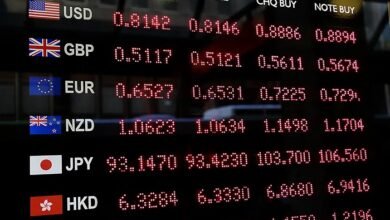Currency Derivatives: A Comprehensive Guide

Introduction
Currency derivatives are financial instruments that derive their value from the exchange rate of two or more currencies. These instruments are used by investors, traders, and corporations to hedge against foreign exchange risk, speculate on currency movements, or gain leverage in the forex market. In the ever-evolving global economy, understanding currency derivatives is crucial for effective financial planning and risk management.
Types of Currency Derivatives
There are several types of currency derivatives, including futures, options, forwards, and swaps. Each type has its own unique characteristics and uses:
- Currency Futures: Standardized contracts traded on exchanges to buy or sell a currency at a future date.
- Currency Options: Contracts giving the buyer the right, but not the obligation, to buy or sell a currency at a specific price before a certain date.
- Currency Forwards: Customized contracts between two parties to exchange currencies at a predetermined rate on a future date.
- Currency Swaps: Agreements to exchange cash flows in different currencies between parties over a period.
Understanding these types of currency derivatives helps investors choose the appropriate instruments for their needs.
The Role of Currency Derivatives in Hedging
Currency derivatives play a vital role in hedging against foreign exchange risk. Businesses involved in international trade use these instruments to lock in exchange rates and protect against adverse currency movements. For example, a U.S. company expecting payment in euros can use a currency forward to ensure they receive a fixed amount of dollars, regardless of future exchange rate fluctuations.
Speculation and Currency Derivatives
Apart from hedging, currency derivatives are widely used for speculation. Traders use these instruments to profit from anticipated movements in exchange rates. By leveraging positions in currency futures or options, speculators can amplify their gains (or losses) based on market volatility. This speculative activity adds liquidity to the forex market, making it more efficient.
Benefits of Trading Currency Derivatives
Trading currency derivatives offers several benefits:
- Risk Management: Helps mitigate exchange rate risks.
- Leverage: Allows traders to control large positions with relatively small capital.
- Flexibility: Various instruments to suit different trading strategies.
- Liquidity: High trading volumes ensure easy entry and exit from positions.
- Market Access: Provides access to global currency markets.
These benefits make currency derivatives an attractive option for both individual and institutional investors.
Risks Involved in Currency Derivatives
While currency derivatives offer numerous advantages, they also come with significant risks:
- Market Risk: The risk of losses due to unfavorable exchange rate movements.
- Credit Risk: The possibility of a counterparty defaulting on a contract.
- Liquidity Risk: The risk of not being able to exit a position easily.
- Operational Risk: Risks related to system failures or human errors.
Understanding these risks is essential for anyone involved in trading or using currency derivatives for hedging purposes.
Trading Strategies Using Currency Derivatives
There are several trading strategies that investors use with currency derivatives:
- Carry Trade: Borrowing in a low-interest-rate currency to invest in a high-interest-rate currency.
- Hedging Strategies: Using forwards, futures, or options to protect against adverse currency movements.
- Speculative Strategies: Taking positions based on expected changes in exchange rates.
- Arbitrage: Exploiting price differences in different markets to earn risk-free profits.
These strategies can help investors optimize their returns while managing risks effectively.
Regulatory Environment for Currency Derivatives
The trading of currency derivatives is subject to regulatory oversight to ensure market integrity and protect investors. Regulatory bodies like the Commodity Futures Trading Commission (CFTC) in the U.S. and the European Securities and Markets Authority (ESMA) in Europe set rules and guidelines for trading these instruments. Compliance with these regulations is crucial for market participants to avoid legal issues and maintain market stability.
The Impact of Currency Derivatives on Global Markets
Currency derivatives have a significant impact on global financial markets. They facilitate international trade and investment by providing mechanisms to manage currency risk. The liquidity and price discovery provided by these instruments contribute to the efficiency and stability of the forex market. Additionally, the activity in currency derivatives markets can influence central bank policies and exchange rate dynamics.
Future Trends in Currency Derivatives
The market for currency derivatives is constantly evolving. Future trends include the increased use of technology, such as algorithmic trading and blockchain, to enhance efficiency and transparency. The growing interest in emerging market currencies and the development of new financial products will also shape the future landscape of currency derivatives trading. Staying informed about these trends is essential for market participants to adapt and thrive in this dynamic environment.
Conclusion
Currency derivatives are powerful tools for managing foreign exchange risk, speculating on currency movements, and facilitating global trade. Understanding the various types, benefits, risks, and trading strategies associated with these instruments is crucial for anyone involved in the forex market. As the financial landscape continues to evolve, staying informed about regulatory changes and future trends will help investors and businesses make informed decisions and navigate the complexities of currency derivatives effectively.
FAQs
- What are currency derivatives? Currency derivatives are financial instruments whose value is derived from the exchange rates of two or more currencies. They include futures, options, forwards, and swaps.
- How do currency derivatives help in hedging? Currency derivatives allow businesses and investors to lock in exchange rates, protecting against adverse currency movements and reducing foreign exchange risk.
- What are the main risks associated with currency derivatives? The main risks include market risk, credit risk, liquidity risk, and operational risk. Understanding and managing these risks is crucial for successful trading.
- What are some common trading strategies for currency derivatives? Common strategies include carry trades, hedging strategies, speculative strategies, and arbitrage. These strategies help optimize returns and manage risks.
- What future trends are expected in the currency derivatives market? Future trends include increased use of technology, interest in emerging market currencies, and the development of new financial products. These trends will shape the future of currency derivatives trading.





